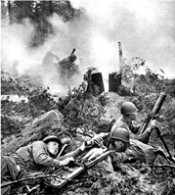
The defense of the Hero City Tula began
October 24, 1941 began Tula defense operation - part of the Battle of Moscow in 1941-1942. The most important part of the operation was the heroic defense of Tula.
In the course of Orel-Bryansk defense operation in September-October 1941, the Soviet forces, holding the German advance on Moscow and pinning down a large force of the enemy, moved to new defensive lines. The defense of the approaches to Tula was assigned to the 50th Army under the command of Major General A. N. Ermakov.
October 24 the 2nd Panzer Army of Germans under the command of G. Guderian began to advance from the line of Belev – Snezhed River estuary, making the main blow in the direction of Tula. By October 30 the German advance units reached the immediate approaches to the city, but all enemy’s attempts to seize Tula straight off were repulsed. By this time the 50th Army, holding the line, was joined by other units and elements: Tula working regiment, the 108th Panzer Division, the 156th Infantry Regiment of the NKVD, etc. Not having succeeded in the front breakthrough, the enemy attempted to round the city from the south-east and east, but on November 7 the units of the 50th Army and the 3rd Army under the command of Major General J. G. Kreizer caused a counterattack on the flanks of the advancing group, forcing it to stop the attack. During the next 10 days, the German troops tried unsuccessfully to break through to Tula in various sectors, and soon the enemy was forced to pass to the defensive.
After the regrouping, the 2nd Tank Army of Germans including four tank divisions, three motorized divisions, five infantry divisions and the motorized regiment "Great Germany" resumed the offensive through Kashira. By the end of November 20th the enemy broke through the defense of the 50th Army, and creating a gap in it on the left flank, managed to develop an attack on Venev. To close this gap, the Headquarters sent to Stalinogorsk from its reserve the 239th Infantry Division under the command of A. Martirosyan. By its efficient actions the division improved the general situation, but happened to be encircled. November 24 the advance units of Germans reached Kashira, having deeply surrounded Tula from the east, but three days later they were counterattacked and by early December pushed back from the occupied positions.
In the north sector the Germans stroke a blow in the direction of Serpukhov and Podolsk, and by the end of December 3, the enemy was able to capture the road and the railway Serpukhov-Tula, cutting off the communications of the 50th Army. But that was the last success of the Wehrmacht near Moscow. German troops were deprived of the necessary equipment to conduct combat operations in harsh winter, and, meeting fierce resistance of the Red Army, suffered huge losses. In order to release the encircled, December 4, the 340th Infantry Division and the 112th Panzer Division counterattacked the flank of the enemy, supported from the south by the defenders of Tula. The advancing German troops were forced to stop, and on 5 December the 2nd Panzer Army led by Guderian, scattered along the front at 350 km, was ordered to move to defense. Tula defense operation, which lasted 43 days, was completed.
The fact that Soviet forces managed to hold Tula, which was half encircled and subject to artillery and mortar fire and air strikes, helped to stabilize the front line on the southern outskirts of Moscow. The main objective of the operation "Typhoon" in October - November 1941 was not achieved: the capital was not seized, and the resistance of Soviet troops was not broken. Despite the complex situation at the front, and the evacuation of most of the companies of Tula to the eastern regions of the country, the defense industry continued to function in the city, producing small arms and artillery weapons, repairing armor.
December 7, 1976, for the courage and resilience shown by the defenders in the heroic defense of the city, which played an important role in defeating the enemy near Moscow, Tula was awarded the honorary title of "Hero City".
Lit.: Битва под Москвой. Хроника, факты, люди: В 2-х кн. М., 2001; То же [Электронный ресурс]. URL: http://militera.lib.ru/docs/da/moscow/index.html; Болдин И. В. Непобеждённая Тула // Провал гитлеровского наступления на Москву. М., 1966; То же [Электронный ресурс]. URL: http://militera.lib.ru/memo/russian/moscow25/08.html; Брежнев Л. И. Выдающийся подвиг защитников Тулы. М., 1977; Битва за Тулу. Сборник документов и материалов. Тула, 1969; Волков В. Ю. От Тулы до Курляндского полуострова. По боевому пути 30-й гвардейской Рижской Краснознаменной стрелковой дивизии [Электронный ресурс] // Военная литература (militera.lib.ru), 2010. URL: http://militera.lib.ru/memo/russian/volkov_vj/index.html ; Гудериан Г. Удар на Тулу и Москву // Гудериан Г. Воспоминания солдата. Смоленск, 1999; То же [Электронный ресурс]. URL: http://militera.lib.ru/memo/german/guderian/06.html; Eлькин А. А. 50 дней мужества. Тула, 1976; История второй мировой войны. 1939—1945. Т. 4. М., 1975; То же [Электронный ресурс]. URL: http://militera.lib.ru/h/12/04/index.html; Климов И. Д. Героическая оборона Тулы. М., 1961; Они защищали Тулу. Воспоминания и очерки Тула, 1965; Туманов А. С. Тула: Страницы хроники героической защиты города-героя в 1941 г. М., 1985.
Based on the Presidential Library’s materials:
Битва под Москвой: [фрагменты кинохроники / реж. монтажа Т. И. Дьяконова]. СПб., 2010.

